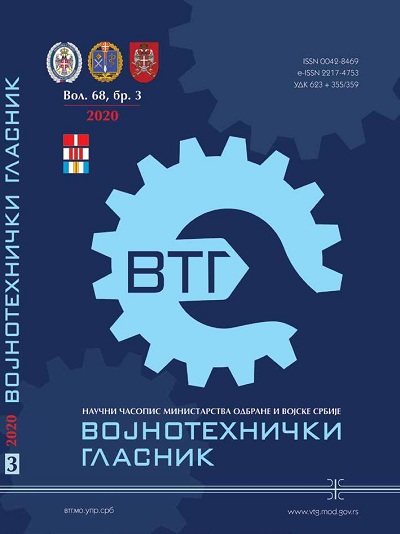Praćenje korona virusa COVID-19 slično je instrumentalnom letenju
Sažetak
Uvod/cilj: Radi posmatranja epidemije COVID-19 u svakoj pojedinačnoj državi na svetu razvili smo specifičan sistem koji se sastoji od sledećih dijagrama i matematičkih modela: a) epidemiološke krive, b) histograma zaraženih osoba, c) historama zaraženih osoba u prethodnih pet dana, d) dvostruke logaritamske krive za posmatranje brzine širenja epidemije, e) epidemiološkog višeparametarskog praćenja f) Gausove i Bolcmanove S-krive. Kao što je pokazano u ovom radu posmatranje toka epidemije nalik je instrumentalnom letenju.
Metode: Najkompleksniji model predstavlja izračunavanje nepotpune Gausove krive, što je detaljnije analizirano u radu. Takođe, pokazano je da postoji vremenska zavisnost između Gausove i S-krive. Podaci su preuzeti sa sajta Svetske zdravstvene organizacije. Potpuni skup podataka sastoji se od Gausove krive, dvostruke logaritamske krive i epidemiološke krive, koje se posmatraju uporedo. Posmatranje samo jedne od naznačene tri krive u velikom broju slučajeva nije dovoljno.
Rezultati: Kako bi se dokazale izabrane metodologije, rad sadrži desetak rezultata u obliku dijagrama.
Zaključak: Kada se izračuna Gausova kriva može se doći do podatka o kraju epidemije. Međutim, u nekim slučajevima Gausova kriva se ne može izračunati, pa kraj epidemije nije jasan, najčešće zato što mnoge države nisu deklarisale broj oporavljenih pacijenata na adekvatan način. Zato se mora uzeti u obzir dvostruka logaritamska kriva. Samo kombinacijama tri dijagrama dobija se pravi uvid u doošenje ispravnih odluka.
Reference
Ferguson, N.M., & et al. 2020. Impact of non-pharmaceutical interventions (NPIs) to reduce COVID19 mortality and healthcare demand. Report 9, Imperial College London, pp.1-20. Available at: https://doi.org/10.25561/77482.
Flaxman, S., & et al. 2020. Estimating the number of infections and the impact of non-pharmaceutical interventions on COVID-19 in 11 European countries. Report 13, Imperial College London, pp.1-35. Available at: https://doi.org/10.25561/77731.
Gauss, C.F. 1809. Theoria motus corporum coelestium in sectionibus conicis solem ambientium. Hamburgi: sumtibus Frid. Perthes et I. H. Besser (in Latin). Available at: https://doi.org/10.3931/e-rara-522.
Kočović, P. 1998. Geometrijsko modeliranje, vol 1. Belgrade: Petar Kočović (in Serbian).
Kočović, P. 2020. Petar Kočović - Gausova kriva i prognoza COVID-19 epidemije [online] Available at: https://www.youtube.com/watch?v=4kguYa7Po2U [Accessed: 29 April 2020].
Kočović, P., Kočović, Z., & Kočović, V. 2020. Petar Kočović's COVID-19 statistics and trends [online]. Available at: http://digital-dreams.biz/COVID-19/index.php [Accessed: 29 April 2020].
Laplace, P.S. 1774. Mémoire sur la probabilité des causes par les évènements. Mémoires de Mathematique et de Physique, 6, pp.621-656 (in French) [online]. Available at: https://www.biodiversitylibrary.org/item/86068#page/7/mode/1up [Accessed: 1 May 2020].
Mann, P.S. 1994. Statistics for Business and Economics. Hoboken, New Jersey: Willey.
-McKinsey & Company. 2020. COVID-19: briefing Materials [online]. Available at: https://www.mckinsey.com/~/media/mckinsey/business%20functions/risk/our%20insights/covid%2019%20implications%20for%20business/covid%2019%20april%2013/COVID-19-facts-and-insights-april-24.ashx [Accessed: 12 April 2020].
Reséndiz-Muñoz, J., Corona-Rivera, M.A., Fernández-Muñoz, J.L., Zapata-Torres, M., Márquez-Herrera, A., & Ovando-Medina, V.M. 2017. Mathematical model of Boltzmann's sigmoidal equation applicable to the set-up of the RF-magnetron co-sputtering in thin films deposition of BaxSr1-xTiO3. Bulletin of Materials Science, 40, pp.1043-1047. Available at: https://doi.org/10.1007/s12034-017-1441-x.
Stahl, S. 2006. The Evolution of the Normal Distribution. Mathematic Magazine, 79(2), pp.96-113. Available at: https://doi.org/10.1080/0025570X.2006.11953386.
-World Health Organization. 2020. Coronavirus disease (COVID-2019) situation reports [online]. Available at: https://www.who.int/emergencies/diseases/novel-coronavirus-2019/situation-reports/ [Accessed: 18 May 2020].
Vojnotehnički glasnik omogućava otvoreni pristup i, u skladu sa preporukom CEON-a, primenjuje Creative Commons odredbe o autorskim pravima:
Autori koji objavljuju u Vojnotehničkom glasniku pristaju na sledeće uslove:
- Autori zadržavaju autorska prava i pružaju časopisu pravo prvog objavljivanja rada i licenciraju ga Creative Commons licencom koja omogućava drugima da dele rad uz uslov navođenja autorstva i izvornog objavljivanja u ovom časopisu.
- Autori mogu izraditi zasebne, ugovorne aranžmane za neekskluzivnu distribuciju rada objavljenog u časopisu (npr. postavljanje u institucionalni repozitorijum ili objavljivanje u knjizi), uz navođenje da je rad izvorno objavljen u ovom časopisu.
- Autorima je dozvoljeno i podstiču se da postave objavljeni rad onlajn (npr. u institucionalnom repozitorijumu ili na svojim internet stranicama) pre i tokom postupka prijave priloga, s obzirom da takav postupak može voditi produktivnoj razmeni ideja i ranijoj i većoj citiranosti objavljenog rada (up. Efekat otvorenog pristupa).

